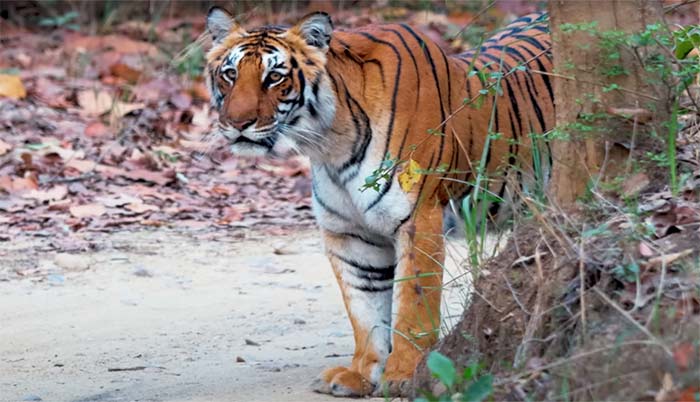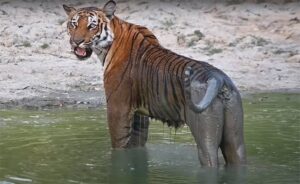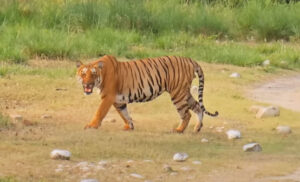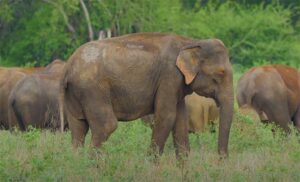The Jhirna Zone stands as a prominent ecotourism area within the Jim Corbett National Park, comprising seven designated zones. Established in 1994, the Jhirna Zone was incorporated into the park’s framework to expand the Tiger reserve area.
This expansion involved the inclusion of agricultural lands from Jhirna village and two other villages, necessitating the relocation of these settlements to alternative locations. The vacated lands underwent redevelopment, transforming into a vibrant and diverse lush forest ecosystem.
Distinguished by its operational status throughout the year, the Jhirna Zone offers wildlife safaris consistently, in contrast to other zones that close during the monsoon season. This accessibility ensures a steady influx of visitors all year-round.
Location of Jhirna Zone
Jhirna is situated on the southern periphery of the Jim Corbett National park. In addition to its tiger population, this zone is home to sloth bears and wild elephants, providing captivating sights for wildlife enthusiasts. The Jhirna zone remains accessible year-round and is renowned for being one of the most visually appealing areas within the Corbett national park.
Access to the Jhirna Zone for day visits is facilitated through the Dhela Gate, located 18 kilometers from Ramnagar. The predominant topography of this region primarily consists of deciduous and secondary forests, interspersed with expansive open grasslands. This landscape enhances visibility, offering an excellent opportunity to observe and appreciate a diverse array of wild animals.
Formalities to enter into Jhirna Zone
Primarily, private vehicles are prohibited within the designated zone. Those desiring to explore the Jhirna Zone are required to reserve a Jeep Safari. Each jeep can accommodate up to six adults and two children. Additionally, there are restrictions on the number of jeeps permitted entry into the zone.
Therefore, to gain access to the Jhirna Zone, it is imperative to procure a safari permit from the forest authorities. Additionally, one must arrange for the hire of a designated safari vehicle and engage the services of a qualified naturalist/guide.
The entry point to the Jhirna Zone is the Dhela Gate, situated approximately 18 kilometers from Ramnagar, the nearest town, and transportation hub which includes the railway station and bus stand. Jhirna Zone safaris are conducted year-round, featuring two shifts per day, each accommodating a maximum of 30 Jeeps. For a streamlined experience, permits, safari vehicles, and guides for Jhirna Safari, along with nearby accommodation options can be conveniently arranged through our website.
Quick Facts about this Safari Zone
- Zone Entry Gate – Dhela Gate
- Distance from Ramnagar – 18 KM
- Operational Period – Open year-round (subject to road and weather conditions)
- Safari Type – Day Jeep Safari
- Maximum Number of Jeep Allowed – 30 Jeeps per Shift (Two Shifts per day)
- Staying option inside Zone – Yes, Jhirna Forest House
- Duration of Exploration – 3 hours and 30 minutes
Timings and Safari Prices:
There are two times you can go on a Jeep Safari in the morning or in the evening, and these timings can vary based on the season, summer timings may differ from winter timings.
| Winter timings | ||
| Safari Types | Entry Time | Exit Time |
| Morning Safari | 07:00AM | 10:00AM |
| Evening Safari | 02:00PM | 05:30PM |
| Summer timings | ||
| Safari Types | Entry Time | Exit Time |
| Morning Safari | 06:00AM | 09:30AM |
| Evening Safari | 03:00PM | 06:30PM |
As far as the cost of Jeep Safari is concerned, each Jeep may cost you between ₹6500 and ₹7500, and this cost may increase during the peak season. As mentioned earlier, one Jeep can accommodate 6 adults and 2 children to enter the zone. So, if you are a group of 6 people, the individual cost can range from ₹1000 to ₹1300.
Flora and Fauna at Jhirna Zone
The place has wide grasslands called Chaur. It mostly has dry areas with some smaller forests. There are many streams, and their beds are warm and easy to explore. Next to the streams, there are cliffs where you can enjoy bird watching.
Recognized as one of the prime locations for observing tigers in their natural environment, this zone is imperative for wildlife enthusiasts and is highly recommended for visitation.
Best time to Visit
The Jhirna Zone is open for visitors all year round, so you can visit anytime. However, from July to September during the monsoon season, you can’t book safaris in advance because they might get canceled on the day due to heavy rain or bad weather. To make it convenient, you can get day permits for safaris directly from the counter on the same day.
Famous attractions
The Jhirna Zone is renowned for its daytime safari activities conducted throughout the entire year. Jungle safaris are facilitated through the utilization of registered jeeps, and the presence of registered nature guides is obligatory for all wildlife trips.
Moreover, within the zone, substantial grassland named Laldhang Chaur is situated, serving as a preferred habitat for plant-eating animals like elephants and deer.
Near By Attractions:
There are some notable tourist attractions near the entry gate of Jhirna Zone, including Garjiya Devi Temple, Kosi River, Dhangarhi Museum, Sitabani Temple, and Shri Hanuman Dham.
- Garjiya Devi Temple (32 KM)
- Kosi River (21 KM)
- Dhangarhi Museum (36KM)
- Sitabani Temple (41KM)
- Shri Hanuman Dham (26KM)
How to reach Jhirna Zone
Latitude – 29.4156° N, Longitude – 78.9939° E
The entry gate of the Jhirna Zone is just 18 km away from Ramnagar. The city of Ramnagar is well-connected by road and train transportation. However, the nearest airport, Pantnagar, is approximately 99 km away from the entry gate of Jhirna.
To explore the Jhirna Zone, you need to have a registered jeep. You can book your jeep in advance by contacting Jai Bhumia Travels or any other travel agent or safari provider situated in Ramnagar.
If you are traveling during the monsoon season, you can book a Jeep Safari on the spot from any travel agent, such as us, or from the designated counter.
Experience at Jhirna Safari Zone: A Lesson in Managing Expectations.
My visit to Jhirna Safari Zone in Jim Corbett National Park back in 2019 was, unfortunately, far from the magical jungle experience we had hoped for. With two excited children and my wife, we were all set for an early morning adventure, only to be met with a frustrating and poorly managed start.
We were asked to be ready by 5:50 AM, but upon meeting the safari guide and driver, I was informed that the permit didn’t even have my name on it. The guide blamed the hotel, and the hotel blamed the guide. Meanwhile, we stood waiting for 30 minutes, and then another 30 minutes at the park gate, while someone rushed from town with the corrected permit. Our safari didn’t begin until 0730, wasting a big chunk of our scheduled time.
Once we entered the park, we drove around for 2 hours, hoping to see some animals that Jim Corbett is famous for. But we only saw three deer and two peacocks—no elephants, no special birds, no tigers, nothing else. This may have been because we missed the early morning time, which other visitors say is better for spotting animals. Ironically, we saw more animals like lemurs, monkeys, and birds outside the park than during the actual safari.
The safari team gave the usual excuse that “nature is unpredictable” and “tiger sightings are rare,” but to me, it just felt like a marketing trick. The only thing they showed us was tiger footprints, which we were supposed to believe made the trip worth it. It really felt like an excuse to cover up the lack of real animal sightings.
Final Thoughts:
Jhirna Zone might offer a decent forest outing, but it’s important to keep your expectations low. In our case, the logistics were disorganized, but that doesn’t mean it will be the same for everyone.
If you’re visiting just to enjoy the forest and spend some quiet time in nature, that’s fine. But if you’re expecting an actual wildlife safari with exciting sightings, this zone might leave you feeling disappointed. That said, some people have mentioned that visiting early in the morning increases your chances of spotting big animals like tigers and elephants.
Recommendation: If you’re visiting with family or kids and hoping for memorable animal sightings, you’re better off exploring more active zones like Dhikala or Bijrani. Or, if you still want to try Jhirna, schedule your safari for early morning. Most importantly, always double-check your safari permit details in advance to avoid the confusion we experienced.




